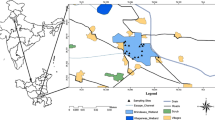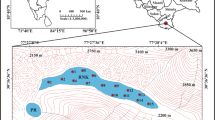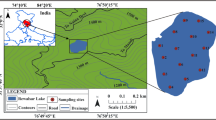Abstract
Large and growing population and rapid pace of development have led to the degradation of natural water system. Lakes are inland bodies of water that lack any direct exchange with an ocean. Lakes may contain fresh or saltwater (in arid regions), shallow or deep, permanent or temporary lakes of all types which share many ecological and biogeochemical processes. Lake ecosystems are influenced by their watersheds, i.e., the geological, chemical, and biological processes that occur on the land and streams. Lakes play multiple roles in an urban setting. It is essential to restore and maintain the physical, chemical, and biological integrity of water bodies to achieve the required water quality, which ensure protection and propagation of fish, wildlife, plants, and also recreation in and on water. The overall goal of this study is to monitor the water quality and assess the trophic status of Bhalswa Lake in Delhi. The trophic status was assessed by using multivariate indices including Carlson Trophic Status Index (CTSI) Sakamoto, Academy and Dobson index, and USEPA-NES which primarily used total phosphorus, chlorophyll-a, and Secchi depth parameters. This study showed that the Bhalswa Lake is in moderate eutrophic condition during the monsoon and post-monsoon period.
Access this chapter
Tax calculation will be finalised at checkout
Purchases are for personal use only
Similar content being viewed by others
References
Sakshi SK, Singh Haritash AK (2017) Environmental biotechnology for control of environmental pollution. In: Proceedings of international conference on emerging areas of environmental science and engineering EAESE-2017, February 16–18, 2017
Shan V, Singh SK, Haritash AK (2017) Water quality Indices to determine the surface water quality of Bhindawas Wetland. In: Proceedings of international conference on emerging areas of environmental science and engineering EAESE-2017, February 16–18, 2017
Gour A Singh SK, Mandal A (2016) Occupational Hazard Posed to labourer operators at landfill sites. In: Proceeding of 3rd International conference on occupational and Environmental Health, 23–25 Sept 2016, New Delhi
Singh SK, Anunay G, Rohit G, Shivangi G and Vipul V (2016) Greenhouse gas emissions from landfills: a case of NCT of Delhi, India. J Climatol Weather Forecast
Gupta D, Singh SK (2015) Energy use and greenhouse gas emissions from waste water treatment plants. Int J Environ Eng-Indersci 7(1):1–10. https://doi.org/10.1504/IJEE.2015.069251
Jaffar MM, Shebli MK, Mussa AKA, Hadi BH, Aenab AM, Singh SK (2015) Detection of Enterobacter sakazakii from Commercial Children Dry Milk. Journal of Environmental Protection 2015 (6), 1170–1175
Singh SK, DhruvKatoriya DM, Sehgal D (2015) Fixed bed column study and adsorption modelling on the Adsorptim of malachite green day from wastewater using acid activated sawdust. Int J Adv Res 3(7):521–529
Abtahi M, Golchinpour N, Yaghmaeian K, Rafiee M, Jahangiri-rad M, Keyani A, Saeedi R (2015) A modified drinking water quality index (DWQI) for assessing drinking source water quality in rural communities of Khuzestan Province. Iran Ecol Indic 53:283–291. https://doi.org/10.1016/J.ECOLIND.2015.02.009
Alam M, Pathak JK (2010) Rapid assessment of water quality index of ramganga river, Western Uttar Pradesh (India) using a computer programme. Nat Sci 8:1–8
Avvannavar SM, Shrihari S (2008) Evaluation of water quality index for drinking purposes for river Netravathi, Mangalore, South India. Environ Monit Assess 143:279–290. https://doi.org/10.1007/s10661-007-9977-7
Bhargava D, Saxena B, Dewakar R (1970) A study of the geopollutants in the Godavary river basin of India. Asian Environ 78:1–4
BIS (1991) Water quality standards indian standard drinking water specification, Bureau of Indian Standard, Indian Standard (10500)
Branchu P, Bergonzini L, Ambrosi J-P, Cardinal D, Delalande M, Pons-Branchu E, Benedetti M (2010) Hydrochemistry (major and trace elements) of Lake Malawi (Nyasa), Tanzanian Northern Basin: local versus global considerations. Hydrol Earth Syst Sci Dis 7:4371–4409. https://doi.org/10.5194/hessd-7-4371-2010
Chandra S, Singh A, Tomar PK (2012) Assessment of water quality values in Porur Lake Chennai, Hussain Sagar Hyderabad and Vihar Lake Mumbai. India Chem Sci Trans 1:508–515. https://doi.org/10.7598/cst2012.169
Chauhan A, Singh S (2010) Evaluation of ganga water for drinking purpose by water quality index at Rishikesh, Uttarakhand. India Rep Opin 2:53–61
Devi Prasad AG (2012) Carlson’s trophic status index for the assessment of trophic status of two Lakes in Mandya district. Adv Appl Sci Res 3:2992–2996
Dwivedi S, Tiwari I, Bhargava D (1997) Water quality of the river Ganga at Varanasi. Inst Eng Kolkota 78:1–4
Fadiran A, Dlamini S, Mavuso A (2008) A comparative study of the phosphate levels in some surface and ground water bodies of swaziland. Bull Chem Soc Ethiop 22:197–206
Goher ME, Hassan AM, Abdel-Moniem IA, Fahmy AH, El-sayed SM (2014) Evaluation of surface water quality and heavy metal indices of Ismailia Canal, Nile River Egypt. Egypt J Aquat Res 40:225–233. https://doi.org/10.1016/J.EJAR.2014.09.001
Joshi DM, Kumar A, Agrawal N (2009) Studies on physicochemical parameters to assess the water quality of river ganga for drinking purpose In: Haridwar District 2:195–203
Author information
Authors and Affiliations
Corresponding author
Editor information
Editors and Affiliations
Rights and permissions
Copyright information
© 2021 The Author(s), under exclusive license to Springer Nature Singapore Pte Ltd.
About this paper
Cite this paper
Dagar, S., Singh, S.K. (2021). Seasonal Behavior of Trophic Status Index of a Water Body, Bhalswa Lake, Delhi (India). In: Singari, R.M., Mathiyazhagan, K., Kumar, H. (eds) Advances in Manufacturing and Industrial Engineering. ICAPIE 2019. Lecture Notes in Mechanical Engineering. Springer, Singapore. https://doi.org/10.1007/978-981-15-8542-5_15
Download citation
DOI: https://doi.org/10.1007/978-981-15-8542-5_15
Published:
Publisher Name: Springer, Singapore
Print ISBN: 978-981-15-8541-8
Online ISBN: 978-981-15-8542-5
eBook Packages: EngineeringEngineering (R0)




